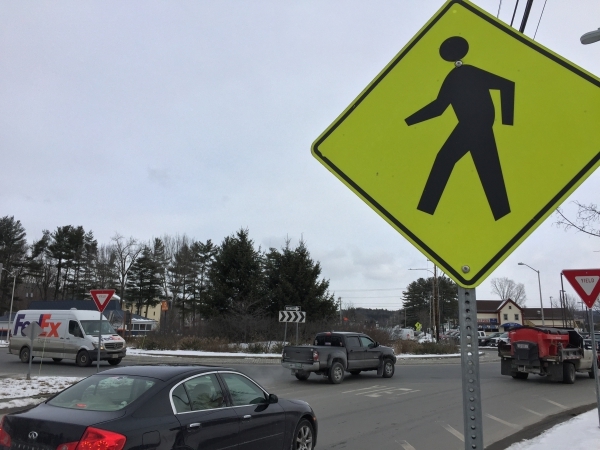BRATTLEBORO — Depending on whom you ask, the roundabout at Interstate 91 Exit 3 is either an effective traffic-flow device or a needlessly confusing mess.
“You do hear people complain about the rotary, but other people really like it,” said Kate O'Connor, Brattleboro Area Chamber of Commerce executive director.
It now appears that there have been enough complaints to spur some modifications: Vermont Agency of Transportation (AOT) officials say they're planning to tweak signs and pavement markings in an attempt to reduce the number of accidents happening in the busy traffic circle.
While that project won't happen right away, it's a response to critics like Sen. Jeanette White, D-Windham, who recently took her concerns to the AOT and the Senate Transportation Committee.
“I am hoping that (AOT) actually heard what my concerns were,” White said. “They are willing to make some changes, and I am hoping they are the changes that many of us have been advocating for.”
The circle at Exit 3 in Brattleboro stands out in two ways. First, it is the transportation agency's only two-lane rotary, said AOT Chief Engineer Kevin Marshia. “Two-lane roundabouts like this one are unique in just the sheer number of turning movements and (traffic) volume,” Marshia said.
The rotary also is uniquely busy: VTrans in 2004 estimated that the intersection handles 20,000 vehicles daily, and that number may have risen since then. In addition to hosting drivers accessing the highway interchange, traffic also flows into the circle from Route 9 in New Hampshire and Route 5 in Vermont.
Officials are worried that too many of those motorists have been bumping into each other. Marshia said there have been 31 crashes in the rotary annually over a 10-year period - a small number compared to the total volume of traffic, but a high enough number to raise some eyebrows at VTrans.
“The good news is, the majority of that is bent metal - minor crashes and no injuries. We're only experiencing one injury per year (on average),” Marshia said.
Critics believe part of the problem is the way traffic is directed into and out of the roundabout. Pavement markings and signs seem to indicate that either of the two lanes is suitable for any of the roundabout's exits, which leads to inner-lane drivers sometimes cutting off those in the outer lane.
White proposes this solution: The right-hand lane should be only for drivers taking the very first exit they encounter. “All other traffic would enter from the left-hand lane into the inner lane in the rotary,” she said.
Marshia agreed that it may be a “lane issue” causing problems in the rotary. “It has contributed to confusion for drivers over the years, and there have been many suggestions for some changes,” he said. “We've heard folks, and we've been having discussions ourselves for a number of years.”
The proposed solution, after a meeting Feb. 11 in Montpelier involving both White and Marshia, is to adopt the senator's proposal via new pavement markings and signs.
“It would function kind of as a one-way roundabout - there wouldn't be two-lane exits,” Marshia said. “At least initially, we'd just do it with striping and change the signage. We wouldn't put in any curbing or anything like that.”
That work will be delayed, however, until the nearby I-91 bridge-replacement project between exits 2 and 3 is finished. The bridge project's chronic traffic backups periodically cause VTrans to shut down part of the Exit 3 interchange, leading to confusion in the rotary.
“What we're committed to is not doing anything (to change the roundabout) until the new bridge on 91 is open,” Marshia said. “We don't want to add another layer of confusion there.”
There's a chance that, even when the new rotary patterns are set, they may have unintended consequences. AOT officials aren't yet convinced that a one-lane-exit model will work at such a busy intersection.
“With everything, there are pros and cons,” Marshia said. “There may be some capacity issues during the peak periods. So it's something we're going to try, and we'll see how it works.”
There's also a chance that drivers will simply ignore the new signs and pavement markings - whether out of carelessness or general confusion. “I don't know whether it's the markings that confuse people, or just the rotary in general,” O'Connor said.
